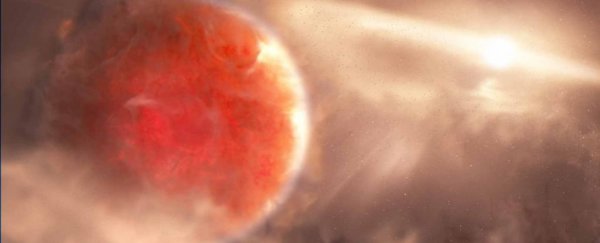The discovery of a gas giant exoplanet still in the process of forming could upend our understanding of planet formation.
The putative protoplanet has been named AB Aurigae b, and it seems to be forming at a large distance from its star, AB Aurigae, and coming together in a rather unusual way.
Evidence suggests that the planet is forming through a top-down gravitational collapse of clouds of gas, rather than the more commonly accepted bottom-up model, whereby planets form from the gradual accumulation of dust and rocks.
This supports the notion that there are multiple pathways for planet formation, suggesting a rich and wonderful diversity of planetary systems in the Milky Way.
AB Aurigae has been intensely studied in recent years. It's a very young star, still forming itself, no more than 5 million years old (the Sun is 4.6 billion years old).
The star is still surrounded by a thick, turbulent disk of gas and dust. When a protostar is growing, this gas and dust is what feeds that growth. Because the star is relatively close – just 508 light-years away – it's an excellent laboratory for studying planetary system formation.
What's left over of that disk will go on to form the other elements that make up a planetary system – the planets, and smaller objects like asteroids, dwarf planets, comets, and other rocks. According to our current understanding of planet formation, these smaller objects can begin to form planets in what's called the core accretion model.
In this model, pieces of rock in the protoplanetary disk of dust and gas stick together, first via electrostatic forces, then via gravity, forming a larger and larger body, building a planet from the bottom up. The resulting exoplanet has a solid core, which form to be relatively cool and dim.
The other model for planet formation is known as the disk instability model. For a planet to form this way, the cooling protoplanetary disk causes gravitational instabilities and breaks apart. Part of the disk then gravitationally collapses directly into a gas giant. In this model, the exoplanet has no solid core, and it forms hotter and brighter.
What's happening in the disk of AB Aurigae, a protostar about 2.4 times the mass of the Sun, has been difficult to tease out.
First, astronomers thought they saw an exoplanet forming at a distance similar to that of Neptune. That interpretation was later called into question by other astronomers, who said the object could be a second star.
In a new study led by astrophysicist Thayne Currie from the National Astronomical Observatory of Japan's Subaru Telescope, a team of scientists used Subaru and the Hubble Space Telescope to take more detailed observations of the star.
The observations revealed a clump and other features in the disk that are consistent with the formation of an exoplanet, not at Neptune's distance from the Sun, but over three times farther, at around 93 astronomical units from AB Aurigae.
"The spiral arm features we observed in this disk are just what we should expect if we have a planet with the mass of Jupiter or more in the presence of these dust structures," says astronomer Kevin Wagner from the University of Arizona's Steward Observatory.
"A massive planet should perturb them into exactly like what we are seeing here."
At that distance, the amount of rock present in the disk would be insufficient to form a planet, never mind one of AB Aurigae b's mass. The team's calculations suggest that the baby exoplanet is about nine times the mass of Jupiter. Instead, the most likely formation pathway is the disk instability model, the researchers said.
"Nature is clever; it can produce planets in a range of different ways," Currie says.
The team also found features in the disk at distances of 430 and 580 astronomical units from AB Aurigae that suggested exoplanets might be forming at those locations, too.
The findings shed some new light on the processes involved in planet formation, and could even help us better understand our own Solar System. There's evidence to suggest that Jupiter formed about four times more distantly than its current orbit.
As such, future studies of the nascent AB Aurigae system using more powerful instruments may allow us to explore the evolution of our own little corner of the galaxy.
"This new discovery is strong evidence that some gas giant planets can form by the disk instability mechanism," says astrophysicist Alan Boss of the Carnegie Institution of Science, who did not participate in the research, but first proposed disk instability in 1997.
"In the end, gravity is all that counts, as the leftovers of the star-formation process will end up being pulled together by gravity to form planets, one way or the other."
The research has been published in Nature Astronomy.
